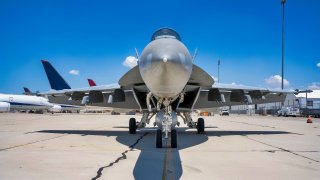The F/A-18 Hornet Is the 'Aviation Spine' of U.S. Navy Aircraft Carriers
The F/A-18 Hornet, initially almost scrapped by the Air Force, became the backbone of the U.S. Navy’s aerial fleet for over four decades.
Summary: The F/A-18 Hornet, initially almost scrapped by the Air Force, became the backbone of the U.S. Navy’s aerial fleet for over four decades.
-Originating from the YF-17 prototype, it was adapted by Northrop and McDonnell Douglas for naval operations.
-The Hornet’s low maintenance needs, versatility, and reliability have ensured its continued relevance.
-The enhanced F/A-18 Super Hornet variant, deployed successfully in various missions, remains vital. Despite newer platforms, the Super Hornet will remain in service for the foreseeable future.
How the F/A-18 Hornet Evolved from Near-Scrap to Naval Powerhouse
While fifth-generation platforms like the F-22 Raptor and F-35 Lightning II appear to get all the media buzz, one older fighter jet in service with the U.S. Navy should not be overlooked so quickly.
The F/A-18 Hornet series of jets has remained the backbone of the service’s aerial fleet for more than four decades.
This fourth-generation platform perhaps plays the most contributive role in the Navy today, despite the introduction of newer platforms.
What many are not aware of, however, is that the supersonic, multirole fighter was almost scrapped altogether back in the day when the Air Force originally turned down the F/A-18.
The history of the F/A-18 Hornet:
During the Cold War, the Navy initiated its Fighter-Attack Experimental (VFAX) program to replace the aging A-7 Corsair II, McDonnell Douglas F-4 Phantom II and Douglas A-4 Skyhawk airframes.
Wanting a platform that could complement the F-14 Tomcat but at a cheaper cost, the service was directed to look over the competitors in the Air Force’s Lightweight Fighter (LWF) program- the General Dynamics YF-16 and the Northrop Grumman YF-17 prototypes.
Ultimately, the YF-16 was selected as the winner of the LWF competition. However, the Navy was not convinced that the platform would be best suited for carrier operations.
In fact, the service eyed the losing YF-17 prototype aircraft instead, specifically its speed, advanced technology and agility.
How the F/A-18 Made It to Service
In order to accommodate the Navy’s defense needs, manufacturer Northrop partnered up with McDonnell Douglas to create an enhanced version of the YF-17 prototype. The new jet was equipped with twin engines for upgraded reliability, advanced avionics for multirole operations and most importantly the ability to launch to and from aircraft carriers.
As summed up by Plane Tags, “The selection of the F/A-18 Hornet was the culmination of a rigorous evaluation process, underscoring its superior design, versatility, and adaptability. From its origins as the YF-17 Cobra, the F-18 evolved into a cornerstone of American naval aviation, setting a new standard for multirole fighter jets. Its development not only reflects the technological advancements of its time but also the strategic vision that continues to shape modern aerial warfare and defense strategies.”
One of the most useful traits associated with the Hornet fighter is maintenance. This aircraft’s mean time between failures is reportedly three times longer than any other strike aircraft in the service’s inventory.
Since this platform operates from the open seas, easy maintenance is truly a blessing in terms of logistics and storage. The Hornet was also one of the first platforms to heavily use multifunction displays to enable pilots to switch from either attack or fighter roles with the press of a button.
Two General Electric F404 engines powered the platform, which proved to be reliable and easily maintainable energy sources.
Introducing the F/A-18 Super Hornet
The Hornet has proved itself in combat time and time again, starting with its first deployment in missions against Libyan air defenses during Operational Prairie Fire and in Operation El Dorado Canyon. The platform was so successful that the Navy has leaned into several more enhanced variants.
Today, the Super Hornet plays a major role for the service. Earlier this year, the Navy’s fleet of F/A-18 Super Hornets made headlines for its role in ongoing operations against the Iranian-backed Houthis in the Middle East. Super Hornets from the USS Eisenhower carrier strike group took out at least a dozen one-way attack drones, several anti-ship ballistic missiles and land attack cruise missiles in the Southern Red Sea this winter in a short half-day period.
According to a statement published by the US central command CENTCOM “On Jan. 9, at approximately 9:15 p.m. (Sanaa time), Iranian-backed Houthis launched a complex attack of Iranian-designed one-way attack UAVs (OWA UAVs), anti-ship cruise missiles, and an anti-ship ballistic missile from Houthi-controlled areas of Yemen into the Southern Red Sea, towards international shipping lanes where dozens of merchant vessels were transiting. Eighteen OWA UAVs, two anti-ship cruise missiles, and one anti-ship ballistic missile were shot down by a combined effort of F/A-18s from USS Dwight D. Eisenhower (CVN 69), USS Gravely (DDG 107), USS Laboon (DDG 58), USS Mason (DDG 87), and the United Kingdom’s HMS Diamond (D34). This is the 26th Houthi attack on commercial shipping lanes in the Red Sea since Nov. 19. There were no injuries or damage reported."
The Super Hornet’s Role in Today’s Naval Operations: Still Going Strong
Although newer and more technologically advanced stealth fighters continue to be procured by the Navy, the latest F/A-18 Super Hornet variants aren't going anywhere for some time.
About the Author: Maya Carlin
Maya Carlin, National Security Writer with The National Interest, is an analyst with the Center for Security Policy and a former Anna Sobol Levy Fellow at IDC Herzliya in Israel. She has by-lines in many publications, including The National Interest, Jerusalem Post, and Times of Israel. You can follow her on Twitter: @MayaCarlin.
Image Credit: Shutterstock.


